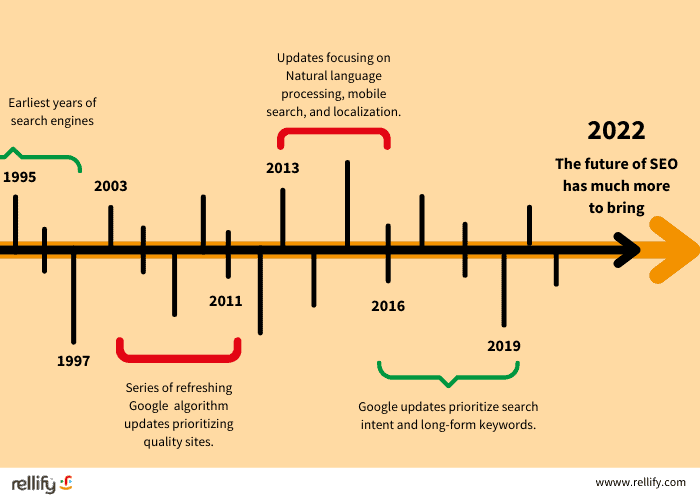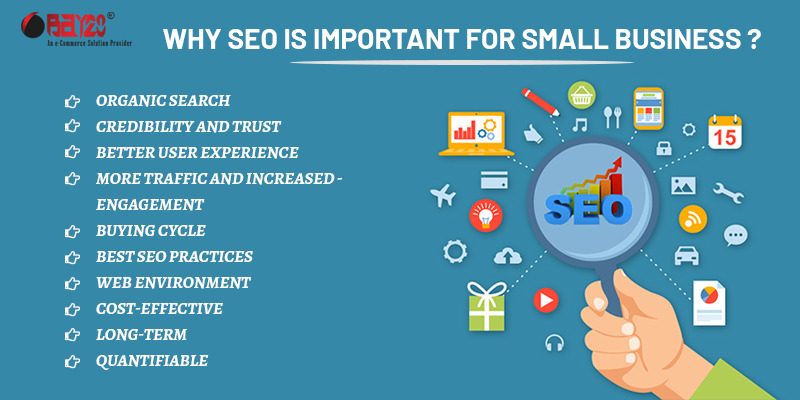Imagine a world where finding information online was like searching for a needle in a haystack.
Sounds daunting, doesn’t it?
In this article, we’ll delve into a brief history of SEO. This was the digital landscape before the dawn of SEO.
Today, when you type a query into a search engine and get precise results in milliseconds, it’s easy to forget the journey SEO has undergone to make this magic happen.
A Brief History of SEO – 1990s The Humble Beginning

Before Google became a household name, the internet was like the Wild West.
In the early ’90s, search engines like Archie and Excite emerged, helping users navigate the vast digital landscape.
But as you can imagine, these engines were primitive, often returning irrelevant results.
It was during this time that website owners realized a golden opportunity: if they could figure out how these search engines ranked sites, they could tweak their websites to appear at the top.
Thus, the first SEO practices were born. However, they weren’t as refined as today. Imagine websites stuffed with repeated keywords just to gain visibility.
Sounds chaotic, right?
The Rise of Google and the 2000s Revolution
In the late 1990s, amidst a sea of emerging search engines, a new player entered the arena: Google. Founded by two Stanford Ph.D. students, Larry Page and Sergey Brin, Google was not just another search engine.
It was a revolutionary force set to redefine the digital search landscape.
At the heart of Google’s innovation was the PageRank algorithm.
While earlier search engines primarily ranked websites based on keyword density and meta tags, PageRank introduced a novel approach.
It evaluated the quality and relevance of content by analyzing the number and quality of links pointing to a page. This meant that for the first time, websites with genuinely valuable content had a fighting chance to rank higher, even if they weren’t stuffed with keywords.
The message was clear: quality would always triumph over quantity in Google’s eyes.
However, as you’re well aware, where there’s a system, there are always those looking for shortcuts.
The early 2000s witnessed the rise of ‘black hat’ SEO techniques. Crafty webmasters tried to manipulate rankings using deceptive methods, such as hidden text, cloaking, and link farms.
These tactics might have offered short-term gains, but Google was on a mission.
Determined to ensure that users received the most relevant and trustworthy results, Google rolled out a series of algorithm updates.
These updates, like Panda and Penguin, were designed to penalize sites employing manipulative tactics and reward those producing authentic, user-centric content.
As the decade progressed, it became evident that succeeding in the world of SEO was not about outsmarting the algorithm but about aligning with its core principle: delivering value to users.
Also read: Off-Page SEO techniques to Boost your Organic Traffic
The Age of Enlightenment: 2010s
As the calendar flipped to the 2010s, the world of SEO was no longer in its infancy.
It had matured into a robust industry, with professionals, agencies, and tools dedicated solely to mastering the art and science of search engine optimization.
This decade was marked by rapid advancements, and Google, the leading force in the search engine realm, was at the forefront of these changes.
One of the standout features of this era was the frequency and depth of Google’s algorithm updates.
Among the most notable were the Panda and Penguin updates. While their names might sound gentle, their impact was anything but.
The Panda update, rolled out in 2011, was designed to reward websites with high-quality, original content and penalize those with duplicated or thin content.
On the other hand, the Penguin update, introduced in 2012, took aim at websites using manipulative link schemes to artificially boost their rankings.
These updates sent a clear message: Google was committed to ensuring that quality, authenticity, and user experience were paramount.
But the 2010s weren’t just about algorithm changes. A significant shift was happening in user behavior.
The rise of smartphones and tablets meant that more people were searching on the go. This transformation had profound implications for SEO. It was no longer sufficient for a website to rank well on desktop searches alone.
The user experience on mobile devices became a critical ranking factor. Websites had to be optimized for mobile, ensuring fast load times, easy navigation, and responsive design.
If you’ve ever tried to navigate a site not optimized for mobile, you know the pinch-and-zoom struggle and the frustration of mis-clicking links.
Recognizing this, Google rolled out the “Mobilegeddon” update in 2015, giving preference to mobile-friendly sites in search results.
In essence, the 2010s were a period of enlightenment for SEO, where the focus shifted from mere rankings to delivering a holistic and seamless user experience across devices.
Related article: Mobilegeddon- A Complete Guide to Google’s Mobile-Friendly Update
Voice Search and the Future: Navigating the New Soundscape of SEO
In today’s fast-paced digital age, the way we interact with technology is undergoing a profound transformation.
One of the most evident shifts is the rise of voice search. If you’ve ever asked Siri for the weather, requested Alexa to play your favorite song, or inquired Google Assistant about the nearest coffee shop, you’ve contributed to this evolving trend.
Voice search is not just a fad; it’s a paradigm shift. Traditional text-based searches required typing, which, while efficient, is not always the most convenient method, especially when multitasking.
Voice search offers a hands-free, direct, and often faster way to obtain information. This is particularly beneficial when you’re cooking, driving, or simply when your hands are full.
Devices like Amazon’s Alexa, Apple’s Siri, and Google’s Assistant are becoming household staples.
Their increasing prevalence signifies a move towards a more conversational and natural way of interacting with technology. Instead of typing “weather today,” you’d ask, “What’s the weather like today?”
This change in query structure means that SEO strategies need to adapt to more natural language patterns and long-tail keywords.
But the evolution doesn’t stop there. The backbone of these voice search technologies is the rapid advancements in Artificial Intelligence (AI) and machine learning.
These technologies enable voice assistants to understand context, nuances, and even different accents. As AI becomes more sophisticated, it’s likely that voice search will become even more intuitive, predictive, and personalized.
Imagine a voice assistant that not only answers your queries but anticipates your needs based on your habits and preferences.
Furthermore, as voice search grows, there’s potential for new forms of content optimization.
Consider the importance of featured snippets or direct answers in voice search results.
When you ask a voice assistant a question, it often reads out the top result or the featured snippet.
This places a premium on securing that coveted “position zero” in search results.
So, what does the future hold for SEO in this voice-dominated landscape?
While it’s hard to predict with certainty, one thing is clear: the SEO strategies of yesterday won’t suffice.
The future will require a keen understanding of conversational semantics, a focus on local SEO (think “near me” searches), and a commitment to providing clear, direct answers that voice assistants can relay to users.
In essence, as the digital world continues to listen more intently to our voices, the realm of SEO will dance to the tunes of spoken words, adapting and evolving in ways we can only begin to imagine.
Also read: Best Marketing Strategies to Follow in 2023
Conclusion

As we reflect on this brief history of SEO, from its inception in the ’90s to the sophisticated algorithms of today, SEO has come a long way.
As you navigate the digital world, remember that at the heart of SEO is the user – you.
Search engines aim to provide you with the best experience, and as technology evolves, SEO will continue to adapt, ensuring that you always find exactly what you’re looking for.




